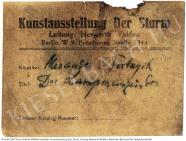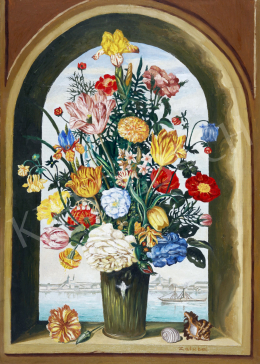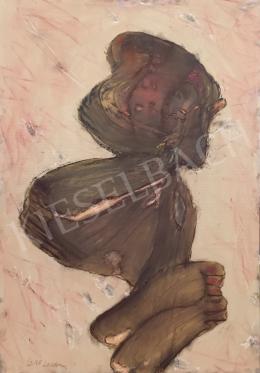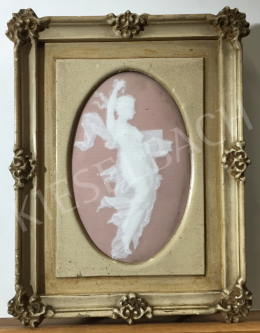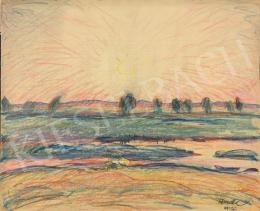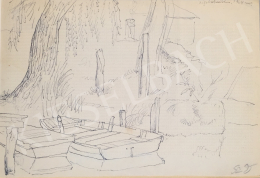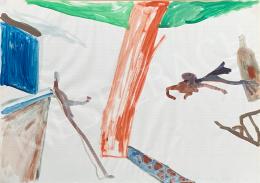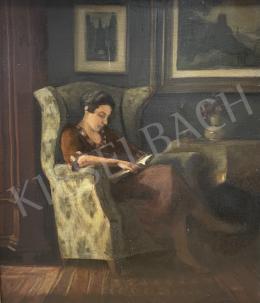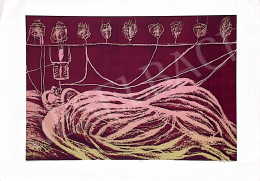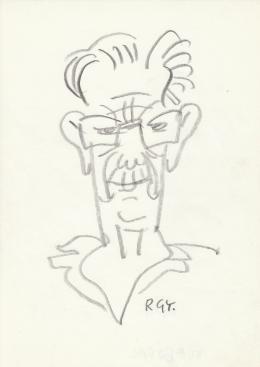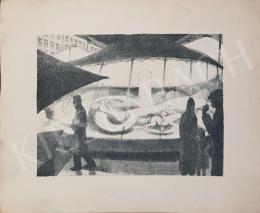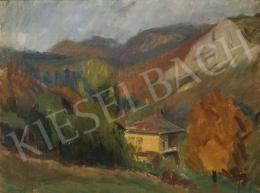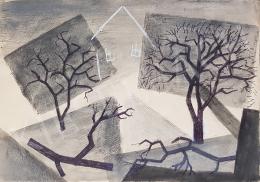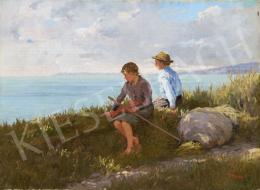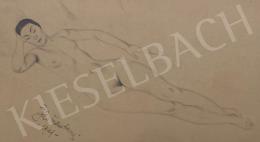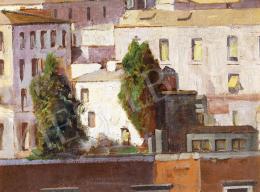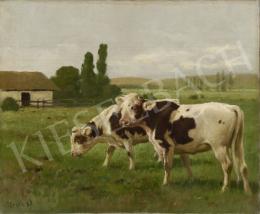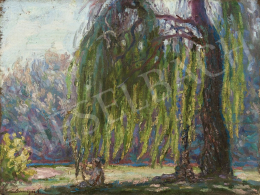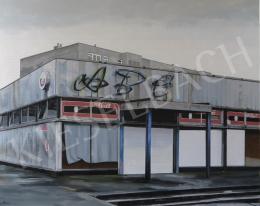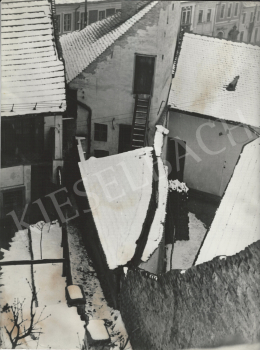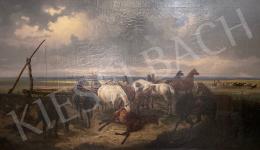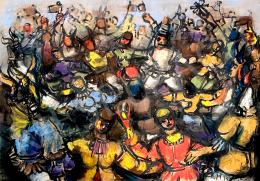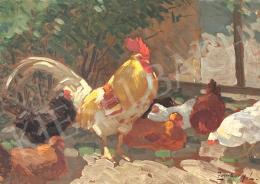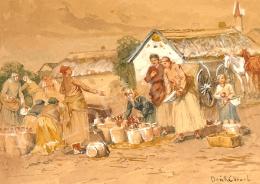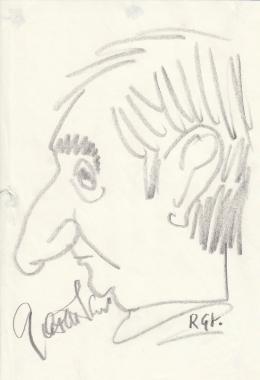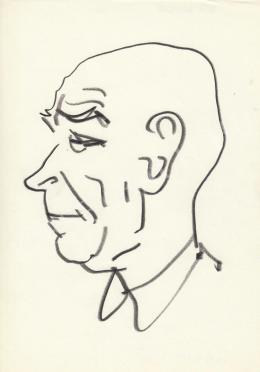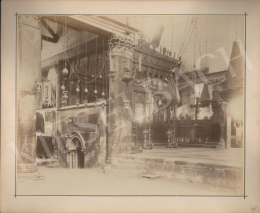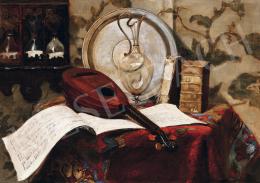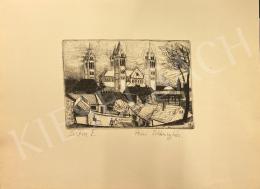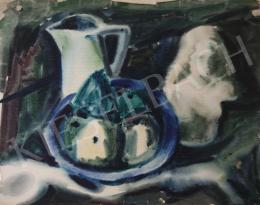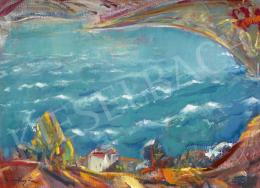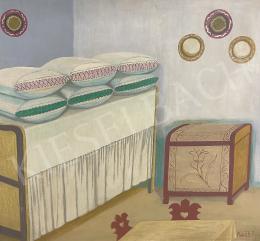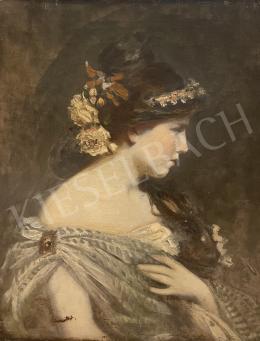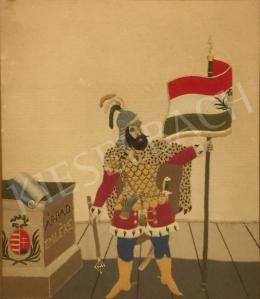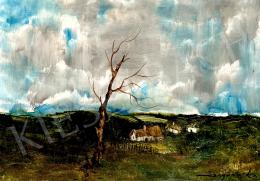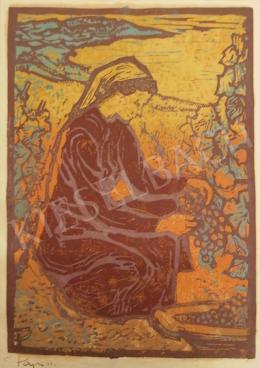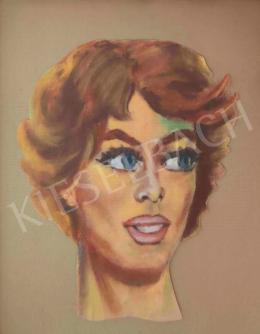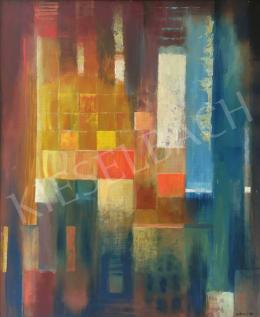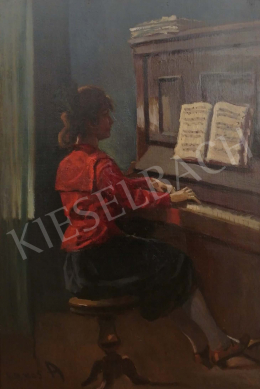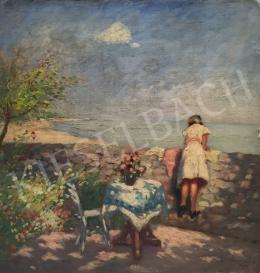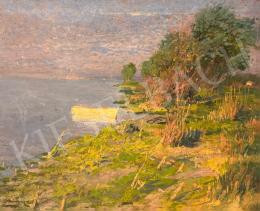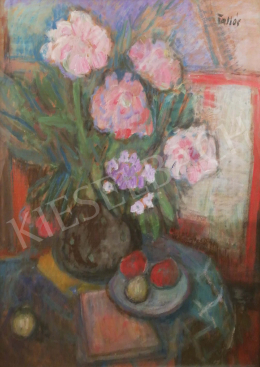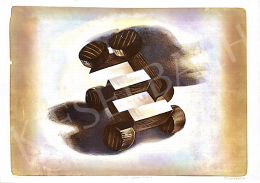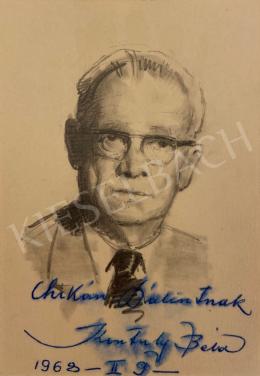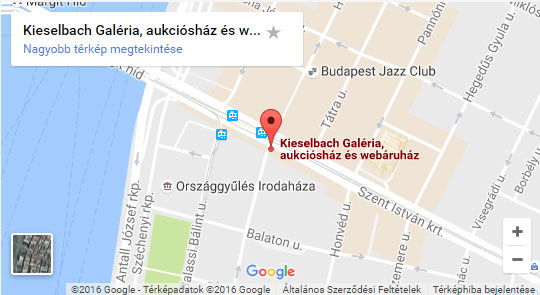Bibliography
Dénes Zsófia: Bortnyik műhelyében. In.: Bécsi Magyar Újság, 1922. február 17.5. l.
Borbély László: Bortnyik Sándor korai művészete.
In.: Művészettörténeti Értesítő, 1969, 46-73. l.
Borbély László: Bortnyik. Budapest, 1971.
Csapó György: Bortnyik. In.: Tükör, 1972 május 23.
Kassák Lajos: Az izmusok története. Budapest, 1972.
Passuth Krisztina: Magyar művészek az európai avantgárdban. Budapest, 1974.
Bortnyik Sándor emlékkiállítása. Katalógus. Magyar Nemzeti Galéria, Budapest, 1977.
Hevesi Iván: Az új művészetért. Válogatott tanulmányok. Budapest, 1978.
Georg Brühl: Herwarth Walden und "Der Sturm". Lipcse, 1983.
Kassák Lajos 1887-1967. A Magyar Nemzeti Galéria és a Petőfi Irodalmi Múzeum emlékkiállítása. Szerk.: Gergely Mariann, György Péter, Pataki Gábor. Budapest, 1983.
The Société Anonyme and the Dreier Bequest at Yale University. A Catalogue Raisonné.
Ed.: Ruth L. Bohan. New Haven & London, 1984.
Bartha Miklós, László Károly: Magyar művészek és a Sturm 1913-1932. Budapest, 1998.
S. A. Mansbach: Standing in the Tempest. Painters of the Hungarian Avant-gard
1908-1930. Santa Barbara, 1991.
Modern Hungarian Painting 1892-1919. Ed.: Kieselbach Tamás. Budapest, 2003.
Modern Hungarian Painting 1919-1964. Ed.: Kieselbach Tamás. Budapest, 2004.
Botár Olivér: Természet és technika. Az újraértelmezett Moholy-Nagy 1916-1923. Budapest, 2007.
Foreword
Different kinds of motivation are to be found for establishing and developing a collection. My strongest motivation was to share my opinion about Hungarian painting with the help of the pieces I owned. Within me, there lay a vision of the ideal collection, a way to present 20th century Hungarian painting, and I looked for the elements to create it. There were painters whose masterpieces I could get quite easily, and there were pieces I pursued for years. Sometimes I found paintings by the same painter, but often I could not find the work of art I longed for, missing pieces from an oeuvre. Sándor Bortnyik is one of these examples. In Hungary, I could not discover the paintings he created in the first part of the 1920s, which I regarded as masterpieces of international stature. I always examined the surfaces of pictures with a great care, and it became clear for me quite early that most of Bortnyik's paintings dated as early pieces were just recreations made by the elderly master. I did not want them. I looked for the real, mature surface, the authentic voice which was not soiled by the manner of the 1960s. At last, after a long search, I found a piece abroad. It was the picture Composition with a Lamp, which was painted in 1923 under the influence of the Weimar Bauhaus. My choice proved to be justified. Since then, the picture has represented Bortnyik's oeuvre and Hungarian painting several times at different exhibitions in the United Stated and Germany.
I am convinced that the upheavals in the course of our history reveal the most characteristic features in Hungarian art. Hardly can we find another country that experienced the tragedies of the 20th century so intensively, forced to relinquish its identity so often. Surely, one of the most important upheavals, a period of radical change, came with the Socialist Republic and the wave of emigration following its fall. That is why the second part of the book I edited, Modern Hungarian Painting, begins with this event. The year 1919 marks one of the greatest upheavals in Hungarian history. Its consequences are almost inestimable. Most of the progressive Hungarian intellectuals escaped to Vienna, Berlin and Paris. This was the beginning of the mass emigration that decimated the Hungarian elite several times during the 20th century. Most of the pieces created during the years of emigration disappeared, so this period, which is one of the most exciting in the history of Hungarian art, is a kind of blank slate for us. Understandably, international interest is especially keen on art from this decade. In these years, Hungarian artists - Lajos Kassák, László Moholy-Nagy and Sándor Bortnyik among them - worked in synchronicity with the most outstanding painters of Europe at that time. Small wonder that Kassák, Moholy-Nagy and Bortnyik became the most well-known Hungarian artists abroad. However, only very few representative pieces survived from this period, so the art of the Hungarian Avant-garde could only be traced through small drawings, collages and lino engravings published in contemporary magazines.
This is the reason why the emergence of The Lamplighter is of fundamental importance. Here we have a painting that reappeared after more than eighty years in hiding, a masterpiece of monumental quality. I am convinced that this painting could be the most important representative of Hungarian Avant-garde both in Hungarian and foreign collections. I have no doubt this holds true in the case of museums as well.
It is difficult to describe what I felt when I first saw the painting. It struck me, so to speak; I was shocked. Could I believe my eyes? At last, I had managed to find a work of art that could represent the Hungarian Avant-garde at its peak. We no longer needed use only our imagination to reconstruct the strength of Hungarian Activism. Besides the fragments, articles and reproductions of old catalogues, we had a real piece of art. Its unique, intense harmony of colours, the perfectly mature composition and its emblematic theme had destined this painting to become the icon, the symbolic quintessential piece of the Hungarian Avant-garde. This indeed was the most important painting from the years when the artist, at the peak of his artistic strength, formulated the idea of the new man with hope and enthusiasm - the new man, who brings light into the darkness, security into the night, someone who suggests the clarity and purity of intellect. And that was only one field of interpretation!
The Lamplighter, just as every masterpiece, held several layers of symbols.
For me, the emergence of Bortnyik's picture is an important justification.
It has strengthened my conviction that the masterpieces which, due to the revival of Hungarian art dealing, have emerged in the past fifteen years will force us to rewrite the history of Hungarian art. I am also sure that under the influence of this painting more and more art-lovers will realise that our art does possess pieces, periods and artists of the very highest calibre. Either the picture will end up in a foreign collection, or it will become part of a Hungarian one. However, one can be sure that it will appear often at different important exhibitions in Hungary and abroad, proving the international importance of Hungarian Modernism.
Tamás Kieselbach
Description
The central figure of the rectangle-shaped picture is the monumental lamplighter, lighter in hand. His face and shoulders are turned to the plane of the picture, and he folds his hands in front of him. Behind the figure, but placed in the lower foreground of the picture, the image of a city extending along a riverside can be seen.
It is night, and the image of the city is covered with light flowing from the two street lamps that stand on slim, green columns.
The lilac, ochre and brown walls of the block of flats are divided by the yellow windows.
The blocks are crowned with triangles constructed of red and brown roofs. Lilac waves run through the blue field of the river, its distant bank bordered by circles of lights, the reflections of the street lamps.
In the centre of the composition, at the end of the stick, in the meeting point of the line of forces, there is a small flickering beam of light.
The stressed elements in the picture - the face of the figure evoking an African mask and the warm, yellow circles of light of the lamp - revolve around this gravitational focal point.
The placement of the motifs of the picture evokes the feeling of a central flowing the turbulence in the arches, straight lines and plains fills the composition with dynamic pulsation.
This is the first time that Sándor Bortnyik's picture The Lamplighter has been exhibited in Hungary. Earlier, it was exhibited only once, 86 years ago in Berlin, in the gallery Der Sturm, the most prominent showroom of the international avant-garde. In an interview conducted in 1922 and published in Vienna, Bortnyik spoke about the painting and how he made it, but until recently there has been only slight hope for the picture's survival. Up until now, the composition has only existed in the form of a line engraving and the well-known recreation, part of the National Hungarian Gallery's collection. The latter was dated to 1921, but actually it was painted only decades later, in the artist's last period. Now, we finally stand before the original monumental masterpiece. There is no doubt that this has been the most significant and absolutely first-rate painting to come to light in the field of Hungarian painting for decades.
It is also beyond dispute that the painting is not only one of the most important works of the oeuvre, but also one of the most prominent pieces of Hungarian Modernism. This piece makes us re-evaluate our knowledge about the early period of Sándor Bortnyik, the leading master of Hungarian avant-garde; at last, the pictures of the early period of emigration can be distinguished from those made in the later years and antedated.
The lost Hungarian Modernism
Hungarian Modernism was born far from the country, in emigration, so the pieces of work created at that time - if they survived at all - were very difficult to find. That is why the emergence of The Lamplighter is extremely important. After some graphics, collages and small paintings, this monumental picture can deservedly represent a period whose Hungarian representatives worked in synchronization with the greatest artists of the international Isms.
The way to Ma
Sándor Bortnyik lost his parents early, and in 1910, he moved from Marosvásárhely to the capital. He began his art studies in the independent school led by József Rippl-Rónai and Károly Kernstok in Haris Alley. In this free-spirited school, which was committed to artistic and social progress, Bortnyik met János Mattis-Teusch, who introduced him to the spiritual leader of the Hungarian Avant-garde, the writer and editor Lajos Kassák, as early as 1916. Kassák had a great influence on the spiritual and artistic development of the young painter. In 1917, Bortnyik's lino engraving was published in the legendary art magazine Ma (Today), and later his works - which showed the influence of German Expressionism, Cubism, Chagall and Kandinsky's panting - were exhibited in the showroom of the magazine several times. Besides graphics and book illustrations, Bortnyik painted oil pictures as well. In some of these (e.g., The Red Engine and The Red Factory), following the basic ethical-ideological position of the Ma circle, the artist used elements from the system of symbols associated with workers' revolution and tried to utilize the psychological strength and symbolic contents of colours. His engravings, which were published on the front-page of the Ma, created a strong visual effect and were easy to understand. The magazine propagated the idea of change, and it is small wonder that the dictatorship of the proletariat and the Socialist Republic gained a crucial importance in the young painter's life.
The Socialist Republic
"We were wolves living outside cages, and the fact that we could howl in our own way meant a compensation for a lot of things." Kassák's words throw light on the spiritual and artistic situation, so characteristic of the Hungarian activists gathered around the Ma in the 1910s, derived from a denial of the ruling power at that time. No wonder that the magazine, which backed the radical left-wing and its revolutional endeavours, became one of the most important spiritual forums of the Socialist Republic. However, the new power - which, at the beginning, was supported by almost all progressive circles of Hungary - soon turned against the magazine, which propagated not only its political commitment, but also its spiritual independence. The history of Hungary, always full of paradoxes, is supplemented by another surprising story: Béla Kun, the leader of the Socialist Republic, called the art of Ma "the product of bourgeois decadence", and, having read Kassák's reaction to his words, he banned the magazine. After the collapse of the Republic, not only the freedom of the magazine, but also that of the people gathered round it was jeopardized. Several artists were forced into exile. The most prominent figures of the Hungarian intellectual life went abroad - writers Sándor Márai, Tibor Déry, Gyula Illyés and Lajos Kassák, as well as painters Károly Kerntock, Aurél Bernáth, Róbert Berény, János Kmetty, Béla Uitz, Vilmos Csaba Perlrott, László Moholy-Nagy, Bertalan Pór and Sándor Bortnyik - just to mention the most important names.
Emigration
Lajos Kassák depicted the state of being an emigrant as follows: "Vienna, 1920. This invalid, this poor, desperate city is our new home. (...) First we were victims of persecution, now we feel like orphans." However, the new situation brought a great ideal of artistic freedom that these people could not enjoy in Hungary. This was the home of the new international Avant-garde, full of fresh impulses from Russia; the artists, who had learnt about the achievements of Dadaism and Constructivism only through black-and-white photos and illustrations, found themselves in the middle of a bustling intellectual and artistic life.
The well-known photo shows Sándor Bortnyik, Lajos Kassák, Béla Uitz, Jolán Simon, Erzsi Ujvári, Andor Simon and Sándor Barta among the new scenes in Vienna. The group, formerly of Ma, was together in Vienna at the beginning of 1920, and the magazine was published again that spring.
Cleaning the oeuvre
When discussing Bortnyik's painting coming to light now and the Viennese period of the painter's oeuvre, impartial examination of the painter's Avant-garde pictures known so far and the re-dating of his works are inevitable. In art dealer and art historian circles, it is a well-known fact that Bortnyik - just like Kassák, Chagall and Hans Arp - re-painted several of his pictures when he was old. When, in the 1960s and 1970s, international interest turned towards Central-European Avant-garde, there was an increased demand for the early pictures of the two most outstanding artists of Hungarian Constructivism, Kassák and Bortnyik.
The elderly masters, for whom the new interest meant a kind of compensation, must have tried to fulfil the expectation of presenting a continuous oeuvre at the exhibitions abroad; so sometimes they recreated the early, lost pictures from the Avant-garde period. In a published letter sent to the elderly Kassák by Victor Vasarely in the winter of 1964, in reference to an exhibition in Denise René's gallery in Paris, the followings can be read: "I am sure that she will make you do the play soon. Of course, she regrets that you have so few pieces. She does not understand why you do not recreate some collages, out of old paper, just signed without date. The chronological entering happens only in the catalogue." It is known that both Kassák and Bortnyik were inclined to re-create their early pictures.
As for Bortnyik, in his case the temptation was even greater, as only a very few pieces from his Vienna, Berlin and Weimar period survived; but he owned drawings, line engravings and photos to "reconstruct" the paintings that disappeared. That is why until recently the works from the first years of emigration have been represented by pictures which were actually painted in the 1960s and which - as a consequence of art historians' compliance - could appear with false dates in books and at prominent international exhibitions. The pieces recreated on the bases of surviving engravings include Ballet (dated to 1920), Acrobats Resting (dated to 1919), Red May, Architect Forbáht with his Wife (dated to 1924), Portrait of Klári (which represented the artist's wife and was recreated at least twice) and Red Pharos, which was dated to 1926, but actually was painted in the 1960s or 1970s. Most of the recreated paintings went to the collection of the Hungarian National Gallery, which bought the pictures from the elderly master himself; however, a most representative foreign collection also happened to acquire recreated pieces. The reason why the painting 20th Century, which can be found in the Thyssen-Bornemissza collection in Madrid, cannot muster real intensity among the most representative works of the avant-garde artist, precisely because the hesitant brushwork of the elderly master cannot mediate the original artistic message of the picture.
Today, despite the critics' arguments, there are photos proving the fact of recreation. Bortnyik's photo estate, part of which became known in 1991, contains several photos made during the 1920s representing the studio and the original paintings. Comparing them to the well-known pictures, the differences are apparent, and this fact automatically requires the impartial re-dating of some paintings.
Bortnyik's most well known picture, The Lamplighter, which was presumably made during the 1960s with the help of a line engraving from 1921, can also be found in the collection of the Hungarian National Gallery. The original painting, which was painted in Vienna and which came to light after eighty years, shows Bortnyik's artistic talent at the peak of his carrier.
The Lamplighter: The Real Panting
For Bortnyik, who lived in emigration, but among Hungarian artist friends, the year 1921 brought different achievements. His illustrations published in Ma and his stencil-printings published in a separate portfolio proved that he made important experiments in the field of constructive picture creation. He must have been one of the first Hungarians experimenting with abstract art as well. However, it is a fact that this brave artistic gesture - which basically meant the practical realisation of Kassák's theory - engaged Bortnyik's attention, which was always open for the new, only for a year. During 1921 - in addition to some small, abstract pieces - he painted a series of monumental tempera paintings. While he created an interesting synthesis of the form-shaping theories of Cubism, Futurism and Constructivism, he also made icons of modern urban heroes (check this!) with a symbolic simplicity characteristic of archaic art. He made pictures in which behind the sight, created with the most modern formal inventions, the social and individual drama of the modern Hungarian art forced into exile can also be discovered.
Zsófia Dénes's interview, which was published in Bécsi Magyar Újság (The Hungarian Paper of Vienna) on 17 February 1922, also sheds light upon Bortnyik's Viennese period and the circumstances of painting The Lamplighter:
"These are the pictures of the transition. Here they are; they are new, from last year. He is laying down craft paper on the floor - the price of canvas is excessively high - on them there are pictures painted with tempera. Tempera, because Bortnyik is able to make it himself, out of powder paint, water, glue and egg white. He prefers oil - but today it is too expensive.
(...)
His red locomotive is running towards us from the infiniteness of deep perspectives. (...) His pictures, The Lamplighter, The Beautiful Melusina, Citizens in a Pub and Café, with a kind of abstract harmony, depict a mood embracing the eternal essence of these concepts, a mood which is quintessence of the lamplighters, prostitutes, pubs and cafés in all times."
The pictures mentioned in the interview have been exhibited only once so far, in Berlin in December 1922, in the rooms of Herwarth Walden's legendary gallery, Der Sturm.
Walden and Der Sturm
The pictures mentioned in the interview have been exhibited only once so far - in Berlin, in December 1922, in the rooms of Herwarth Walden's legendary gallery, Der Sturm.
After two years spent in emigration, Bortnyik got the opportunity to introduce his pictures in the most prominent showroom of the European Avant-garde. Only some of the twenty paintings exhibited there are known today. Besides The Lamplighter, he presumably presented the picture titled Café, and the two paintings bought by Katherina S. Drier, Red Engine and an abstract composition. Today both pictures can be found in the Yale University collection.
Herwarth Walden, the founder of the magazine Der Sturm, played an essential role in the history the European Avant-garde. The enthusiastic editor, art collector and dealer paid ceaseless attention to the representatives of the newest trends and gave the best the opportunity to introduce their works in the capital of modern art, Berlin. He discovered, among others, Marc Chagall. His magazine, Der Sturm, founded in 1910, was more than the propagator of German Expressionism; in a few years, it became the forum for the entire international Avant-garde. It not only followed, but also formed the newest trends. It would be difficult to remember all the names of those whom it helped to fame. The list should contain the artists of the group Der Blaue Reiter, the Italian Futurists, the Russian Constructivists and the Cubists; one should not forget about Balla, Severini, Marc, Kandinsky, Kokoschka, Klee, Delaunay, Archipenco and Chagall, who was one of Walden's favourites. Walden had a sharp acumen for spotting real talent in the bustling artistic life of the era.
One critic wrote that he had been able to pick out those who would later emerge as real talents, even at the beginning of their careers, with an infallible instinct. One of his firsts discoveries was Oscar Kokoschka, whom Walden, as a token of his esteem, charged with editorial tasks as well.
Walden and Hungarian Artists
The relationship between Walden and Hungarian artists goes back to 1916, when Kassák took on the distribution of the magazine Der Sturm in Hungary. This relationship had an important effect. Through the magazine, Hungarian activists could get information about the latest trends and experiments within the international Avant-garde. Around 1920, when plenty of artists were attracted to Weimar by the Bauhaus, there came a crucial change in the point of view of the magazine. Walden pounced upon new talents on the international stage, especially those representing the Eastern- and Central-European culture.
The new Soviet-Russian art occupied the centre of his attention; he was especially interested in the Constructivist trend. Additionally, he also favoured representatives of modern Hungarian art forced into exile. In 1922, he took a deep breath and organized a common exhibition devoted to László Moholy-Nagy and László Péri, two completely unknown artists at that time. This show was one of the first Constructivist exhibitions in Berlin, preceding the first Russian Fine Art Exhibition held by the Galerie van Diemen in the autumn of the same year, which was a milestone in the history of modern art.
Bortnyik's Lamplighter in the exhibition at Der Sturm
In the gallery Der Sturm, December 1922 - the year when Archipenko, Klee, Marc, Schwiters, Moholy-Nagy and Péri exhibited there - Sándor Bortnyik presented twenty pictures made during the two-year-long period of his emigration. Bortnyik, after he broke with Kassák that same year, settled in Weimar, in the new avant-garde centre, which became the home of Bauhaus schools and workshops. Herwarth Walden had already seen some of Bortnyik's lino engravings in the pages of Ma, but 1922 was the year when he really got acquainted with the painter's art. The pictures he saw convinced him, and he undertook the exhibition of selected material, whereby both abstract pictures from his early period and the great tempera pictures made in 1921 - The Lamplighter among them - were shown.
According to the catalogue and contemporaries' recollections, besides some drawings and collages, sixteen paintings made on paper with tempera were presented at the exhibition - The Beautiful Melusina, Citizens' Spring, Marching Soldiers, The Red Locomotive and The Lamplighter among them. The Red Locomotive, which is strongly connected to the picture under discussion, was bought by Katherine S. Drier, together with another non-figurative composition. Dreier was a painter and an art collector, one of the first American supporters of Avant-garde art. She was on friendly terms with the most prominent modern painters of the era and was one of the first to discover Hungarian modernism.
Besides paintings by Bortnyik, she bought pictures by László Moholy-Nagy and László Péri as well. These pictures - together with Bortnyik's Red Locomotive - can be found in the world-famous art collection of Yale University today.
Until this moment, we have had no information about what had happened to the original version of The Lamplighter. (Indeed, most of the paintings presented at Der Sturm disappeared.) In an interview in 1972, Bortnyik himself talked about the disappearance of the picture: "After the fall of the Socialist Republic, some of the Hungarian progressives with the group Ma gathered in Vienna. In 1922, I went to Weimar. While living there, I travelled several times to Berlin, where Herwarth Walden, the editor of the magazine Der Sturm, exhibited my pictures - oil paintings, drawings and aquarelles - 24 pieces altogether. He bought all of them. Later, he sold them to a Swedish collector, but he did not tell me his name. I still don't know what happened to my pictures."
The Lamplighter, symbol of Hungarian Modernism
Symbolic allusions to Bortnyik's early pictures painted in Hungary were all connected to the social and political commitment to activism and to the idea of the left-wing progress. The compositions of the paintings (which also have graphic versions) Red Factory, Red Engine, and Red Sun, created in 1918 and 1919, visually formulated the coming of a new, hopeful era. Bortnyik created the iconography used in literature and poetry, as well as symbols expressing the necessity of a revolution, through the radical reformation of the natural sight.The picture under discussion is the most beautiful and mature example of his endeavours.
"Our motto is the man!" announced the Hungarian emigrant activists at Ma, in the first issue of their fifth volume in Vienna. Bortnyik's picture seems to illustrate this human-centred credo. This time what takes centre-stage is neither the red sun nor the locomotive sweeping away everything, but the new man himself - the man who brings light, knowledge and enlightenment, the man who appears in a halo, the saint of a new age, a symbolic figure among the stark urban setting of the metropolis. He is the messenger of Modernism, who brings sense into the darkness and guards the sleeping city. "Let there be light!" proclaims the Lord in the Old Testament, and Bortnyik's picture - with its icon-like, stylised elements, central composition and monumentality - is the visual expression of this creative gesture. Moreover, it contains allusions to the concept of reason, which is essential to enlightenment, as well as to the motif of taming fire, the story of Prometheus, who brought fire to humanity. Yet, it also evokes the moment when love flares up between man and woman. The figure lighting the gas lamps, closely connected to modern urban life, appears next to water, which reflects the light in the form of yellow discs. Hence, the picture's symbolic world includes the ancient meaning of the river as well. The motif of water contains a rich religious and profane symbolism. In the Christian tradition, it has an essential importance. It is the source of life, it brings rebirth and purification, and it is the symbol of the passage of time.
Consequently, as a background for the lamplighter, it alludes not only to the revolutional changes of the new age, but also to the eternal circulation of history.
Quite possibly, the poem "The Lamplighter is singing" by Dezső Kosztolányi, a great man of letters, also inspired Bortnyik. Kosztolányi's way of thinking and his principles reflected the commitment of the Ma circle at that time. Small wonder that Kosztolányi published his poems in the magazine several times. The message of the abovementioned poem seems so close to that of the picture that one may detect a direct influence.
The barefooted hero of Bortnyik's picture stands before the viewer with a serious gaze, aware of a responsibility both considered and undertaken. He is not a jovial genre figure, but the prophet of a rebelling world, the emblematic symbol of the modern, avant-garde artist. The picture can be interpreted as a hidden self-portrait and - knowing the network of connections among emigrants in Vienna - as the iconic symbol of Bornyik's loved, respected and later disavowed master.
Color and composition
The Lamplighter displays Bortnyik's exceptional sense of colour.
The characteristically expressionist combination of blue, red and yellow, together with the shades of brown and lilac, creates a harmony that suggests eternal balance and perfection.
The centered structure, constructed out of basic forms such as discs and rectangles, and the strong stains of colours complementing each other create a certain quality, lending the picture - which radiates a fairly didactic message - the visual strength of an icon.
The figure of the lamplighter rules the composition.
The painter, following the method of the so-called "greatest surfaces" of Egyptian painting, turns the body of the figure completely to the plane, enlarging the figure by lowering the point of view and adjusting the focus.
The Cubist forms of the buildings, squares and triangles, and the disc-shaped halos suggesting perfection are echoed in parts of the figure, giving the whole surface a homogeneous rhythm. Bortnyik possesses an outstanding talent for creating a basic visual effect that captivates the viewer in an instant.
The picture also betrays the influence of Modernism. In the figure's face, reminiscent of a primitive mask, we can sense Picasso's influence, while the metallic plasticity and the geometric stylisation of the lamplighter's body evoke Fernand Léger's work. The enigmatic decorativeness of The Lamplighter, the virtuoso surface rhythms coated in clear colours, and the perfectly chiselled structure suggesting dynamism - all prove that Bortnyik, while working in emigration, was producing work worthy of the most outstanding masters of European Avant-garde.
Péter Molnos
Sándor Bortnyik in Weimar Germany
Berlin, the metropolis
A publication about the art dealing market registered 778 art and book collectors in Berlin in 1926. One third of them were specialized in paintings - more specifically, in pictures by old masters. Of the collectors of modern works of art, only Dr. Emil Guggenheimer, the respected counsellor, stated that he collected modern paintings. The first collectors of pieces by Béla Czóbel and László Moholy-Nagy cannot be found on the list.
The Berlin of the 1920s must have had rather ambivalent effects on its visitor. On the one hand, the sights in the city were still dominated by the post-war poverty. Worn-out people stood in queues in front of pawnshops, employment and housing offices. Thousands of unemployed nursed invalids, installed radio antennas, gardened in parks, or repaired pipelines and transformers in badly paid communal work. On the other hand, according to Baedekers and programme guides, the city had a bustling cultural and intellectual life. New theatres, cabarets, music halls, cinemas, bookshops and bars opened on the avenues and squares, dotted with colourful placards attempting to draw in an audience.
Art in Cafés
In the first part of the 1920s, in the German capital, which registered four million inhabitants, there were 70 art publishing houses, 56 art shops, 26 auction houses and 10 private showrooms. Most of the galleries catered to the traditional, conservative bourgeois demands.
The artists, mostly painters, were glad to be able to settle down in the bustling metropolis, which was rich in colours, sights and shades. However, only by living there could they experience the difficulties of the emigrant life. The popular artists of the era had a table in the famous Romanisches Café and were regular exhibitors at galleries and in the prominent exhibitions of the Prussian Art Academy. While Lieberman, Menzel, Corinth, Orlik and Slevog were accompanied to their places by the headwaiter, and the leaders of influential galleries and editors awaited them at the table, the new and less popular artists got a table in another corner of the room. The sketch artist John Höxter drawer walked about, easel in hand, looking for customers who wanted to have a portrait for 50 pfennings. He often buzzed around Bertold Brecth, Arnold Zweig and Carl Zuckmayer.
However, in the other centre of Berlin, at the corner of Kurfürsterdamm and Joachimstaler Strasse, there was another café, the Café des Westens, where, in a smoky room decorated with mirrors from the Secession era, another group regularly discussed the new trends - Expressionism, Futurism, Cubism, Modernism - the revolution, the spreading inflation and the lack of money. The leading figures of this group were the musician Herwarth Walden and his first wife, the poet Else Lasker-Schüler, and later Walden's second wife, the painter Nell Walden. The backbone of this bohemian group was the so-called "Red Richard", the group's newsagent, maecenas creditor and messenger at the same time. In 1920, an appalling piece of news went round the tables. The management of the Berlin Art Exhibition changed its mind and took two paintings by Otto Dix off the wall of the pavilion.
Culture in the swamp
Herwarth Walden fought inexhaustibly for the favour of the patrons and donors. The social democratic educational policy of the time treated the Avant-garde movement with a suspicion. The ministries usually supported the state museums, which presented an art independent of politics, in the name of the traditional bourgeois taste. In Berlin, in1922, there were twelve state-owned museums; however, the ministries could not be left untouched by the spirit of the age. Architect Walter Gropious and art historian Adolf Behne founded an advisory staff and helped some leftist artists - Käthe Kollwitz, Ernst Barlach and Heinrich Zille - get into the Prussian Art Academy, which would not have been possible under William II. Meanwhile, the Hohenzollern Museum was temporally closed, and the director of the National Gallery, Ludwig Justin, acquired the crown prince's palace on the Unter den Linden. At this new exhibition place, not only the Impressionists, but also the Bauhaus painters received an opportunity to present their works.
Nevertheless, the glamorous collections, castles and libraries were not enough to feed the people of the country, and the discontent of the working class grew. At the beginning of the 1920s, Germany was in a state between peace and war. There were rebellions, putsches (I do not know this word.), political attempts (What do you mean by "political attempts"? Assassination attempts? Coup attempts?) all the time; and, as the consequence of the French occupation of the Ruhr Area, the country was on the verge of ruin in 1923. The currency lost value, and hyperinflation threatened the country. War damages ran to 132 billion gold marks, which could more or less be settled with the help of the Dawes Plan. However, due to the crash in 1929, another wave of poverty began in Germany, and this polarized the political life of the country.
Herwarth Walden and the Sturm Gallery
Walden was a well-known figure in Berlin. He was the one who first recognised the talent of Thomas Mann, Alfred Döblin and Karl Kraus; and in 1910, he founded the publishing house Der Sturm, published an art magazine and opened a literary stage and a painting school. From 1912 on, he organized exhibitions. First, he rented villas; later, he opened the gallery in his own house. He was the one who introduced to an audience the artists of the group Der Blaue Reiter: Kandinsky, Klee, the Burljuk brothers, Loos and Kokoscka. In 1913, he organized the first German Autumn Salon. The series of exhibitions made the new trend, the Avant-garde, popular in Europe. Among Walden's discoveries, one could find Chagall, Delaunay, Archipenko, Feininger, Léger and Schwitters. Later, his interest turned towards the Eastern-European Avant-garde. The first Hungarian representatives of Der Sturm were János Mattis Teutsch, László Péri, László Moholy-Nagy and Lajos Kassák. They were to be followed by Sándor Bortnyik, Béla Kádár, Aurél Bernáth, Hugó Scheiber, Béni Ferenczy, Gyula Hincz and Lajos d'Ebneth.
The Sturm Gallery could be found in the heart of Berlin, near Potsdamer Platz, at 134 Potzdamer Strasse. It was open from 10 a.m. to 6 p.m. every day except Sunday. The audience consisted mostly of young intellectuals supporting the working class movement. The entrance ticket cost two German marks, just like in other museums. Besides the permanent exhibition, the gallery introduced a new artist every month. It was possible to borrow the pictures, and those interested could read and research in the library of the gallery, where they could find secondary literature and the newest magazines and papers from home and abroad. Every Wednesday a cabaret was performed in the gallery, and at night, a jazz band played for the audience. The annual Sturm Ball, held in February, was considered to be an important social event.
The gallery was easily accessible by car, four-wheeler, bus and tram. According to Eugen Szatmari's Baedeker, the Postamer Platz was the most hectic point within the metropolis. Besides traffic lights, policemen helped to control the traffic. The mailing list of the city shows that in the house of the gallery, prominent lawyers, doctors and health insurance companies saw their clientele. At the left staircase of the backyard, Walden opened a bookshop.
The lamplighters of Berlin
Herwarth Walden met Sándor Bortnyik through the Ma (Today) circle, which brought together the artists of the Hungarian Avant-garde. In 1913, Walden went to Budapest, where he introduced the artists of Der Sturm and cherished his Eastern-European relations. In December 1922, at the 114th exhibition of the gallery, Sándor Bortnyik's The Lamplighter (under the title "Der Lampenanzünder") was exhibited, together with the works of the German Paul Fuhrmann and Oscar Nerlinger.
There were no reviews published about the exhibition. The daily papers, whose cultural column usually got just a few pages, mostly published book and drama reviews. The prominent art magazines, like the Cicerone and the Kunstblatt, published reviews only of pieces by painters who frequented "the table" at the Romanishes Café.
Bortnyik's picture was presented at a good time, as lamplighters were characteristic figures of the city at that time. Until 1925, they brought light into the darkness of the streets at night, and they blew out the lamps at dawn. Kurt Tucholsky, in his writing Laternenanzünder, depicted the procedure very authentically though with a little irony. The chief lamplighter walked the city with two assistants, and holding a photometer in his hand, he decided which lamp should be lighted. Then, he would solemnly point to the chosen lamp and gave the command: "Attention, light!" Afterwards, one of the assistants would climb the ladder and turned the bell. He also oiled the rusty screws, dusted the illuminator and repaired the lamp every month.
Bortnyik's lampligher looked as if he had walked to the gallery straight from Potsdamer Platz.
Hungarian emigrants in Vienna and Berlin
After the fall of the Socialist Republic in 1919, leftist liberalism was over in Hungary, and Avant-garde endeavours were endangered. Most members of the circle Nyolcak (The Group of Eight) as well as activists chose the emigration. The young Hungarian leftists supporting the working class movement found their spiritual home with the Austrian communist elite, which supported the Avant-garde movement at that time. Their everyday problems were sorted out with the help of the workers' association "Red Vienna". At that time, about 40,000 Hungarians - political emigrants, students escaping from the numerus clauses artists, craftsmen, workers and aristocrats - lived in the Austrian capital.
However, Vienna could not compete with the bustling cultural life of Berlin. Small wonder that the Hungarian painters went from Vienna to Berlin as well, where they all paid a visit to Walden. Besides the narrow circle of Der Sturm, there were other prominent Hungarian figures in Berlin: Róbert Berény, Béla Czóbel, Sándor Ék, Károly Kersntock, Alfréd Kemény, László Péri, József Bató and Lajos Tihanyi were among them.
Most of the Hungarians living in Berlin gathered in the Romanisches Café. Ferenc Molnár and later Menyhért Lengyel saw fans and journalists there. The situation was more difficult for Tibor Déry and Milán Füst, who, while drinking their coffee, must have aroused sympathy in publishers. However hard they worked, they could not make ends meet. Sándor Márai worked as the editorial writer of the Frankfurter Zeitung, Háy brought his first plays to the Fischer publishing house, but Lajos Zilahy was the only acknowledged Hungarian writer at that time. However, Kassák's poems were translated and published. Andor Németh, the correspondent of the Viennese Hungarian newspaper, wrote about the launch in May in 1923: "The radical left wing of literature, which is represented by Ma in Hungary and Der Sturm in Germany, is the only one which takes internationalism seriously today."
This was the world Bortnyik found when he arrived in Berlin from Vienna in the autumn of 1922. He could easily find his peers there. As one of them wrote, "there are Hungarians everywhere you go. It is quite natural to see the same faces all the time."
The Bauhaus
It may have been one of Walden's artists, Kurt Schwitter, who invited Bornyik to the international congress of Constructivists and Dadaists in Weimar in August 1922. Schwitter, the Dadaist painter and poet, the publisher of the magazine Merz, was a well-known figure among the members of the Ma circle. Mózes Kahána translated his volume Anneblume into Hungarian. Schwitter gave a collage to Bortnyik in Weimar.
Bortnyik decided to stay in Weimar. He found new inspiration in the Bauhaus and visited the courses of the school. He was interested in the connection between painting and architecture. Though he spent almost four years in Weimar, he did not think of himself as a real representative of it. He visited the courses of Johannes Itten, Vasily Kandinsky, Theo van Doesburg and Paul Klee. Most of the teachers of the Bauhaus school were Walden's discoveries, so the atmosphere was very similar to that of Berlin.
Weimar, which had 38 thousand inhabitants and which was registered as one of the healthiest cities of the country, was full of foreigners at that time. Tourists came to visit the museums shaped from the former dwelling places of Goethe, Schiller and Liszt. The first Bauhaus exhibition, organized by Gropius and Moholy-Nagy among others, opened in August 1923.
The provincial government supported the celebration with 46 million marks. The director's room was furnished with new, innovative pieces; and the "Experimental House", which contained all kinds of Bauhaus objects, attracted a number of visitors. Weimar was the Mecca of young artists, and since more than 20% of the student came from abroad, there was an increased demand for dictionaries. In 1923, the Griebens German-Hungarian dictionary sold out.
Hungarians in Weimar
By the time Bortnyik arrived in Weimar, the Hungarians were quite comfortable there. Marcell Breuer worked in a joiner shop, Andor Weininger had tasks with the stage designers and actors, and Gyula Pap worked under Moholy-Nagy in the metal workshop. Bortnyik rented a studio with terrace at the top of a house; it was soon full of paintings.
The one representing the Forbáth couple was also created here. Bortnyik wrote and illustrated his pantomime The Green Donkey and painted the pictures The New Adam and The New Eve there. From the recollections of Alfréd Forbáth, it is known that the Weimar Hungarians liked staying at Bortnyik's place, where he lived with his wife Klára. Bortnyik also set up a business together with Forbáth and Burchartz, a German photographer. They mainly took on graphic design orders, but the "Neue Reclame Gestaltung" did not exist for a long time. They worked for dollars, because at the peak of inflation, this was the only money that could guarantee their living. There were months when one dollar was worth 600 thousand marks, and a bottle of milk cost 40 thousand marks.
For an outsider who did not know of the professional and personal conflicts within the circle, the artistic life in Weimar could seem quite pleasant. There were get-togethers every week; Weininger played the piano, and at the balls, the artists wore fancy dresses. When Alfréd Forbáth first met his wife-to-be, she was wearing a cube painted black and green. As Johannis Itten's credo ran, "Out of play, there will be celebration; out of celebration, work; out of work, play." That was true. In Weimar, the masters, together with their students, created in the name of artistic and individual freedom.
There are some photos from this era that represent Sándor Bornyik as well.
The Sturm-archive
On 19 August 1926, Herwarth Walden gave his documents and manuscripts, from the period between 1900 and 1919, to the Prussian State Library. In 1924, he divorced Nell Walden. In 1932, he sold additional documents to an Austrian art collector living in Berlin, and in the same year, after publishing the last issue of his magazine, he emigrated to Russia with his new wife. He died in the Gulag in 1941. Most of the pieces of the Sturm estate disappeared. Nell Walden tried to give the common collection to different museums, and in 1954, it came under hammer in Stuttgart - among the pieces, there were seventeen pictures and portfolios by Hungarian artists.
The surviving documents of the gallery Der Sturm can be found in the State Library in Berlin today. The guest book of the Walden-couple and 1300 letters to and by Walden can also be found here. In the letters one can often read about the Sturm labels. It turns out that they were not stuck onto the back of the pictures, but Walden used them as invitation cards for the exhibitions. This means that Bortnyik himself stuck the label "Sturm" on the back of The Lamplighter.
Andrea Dunai







